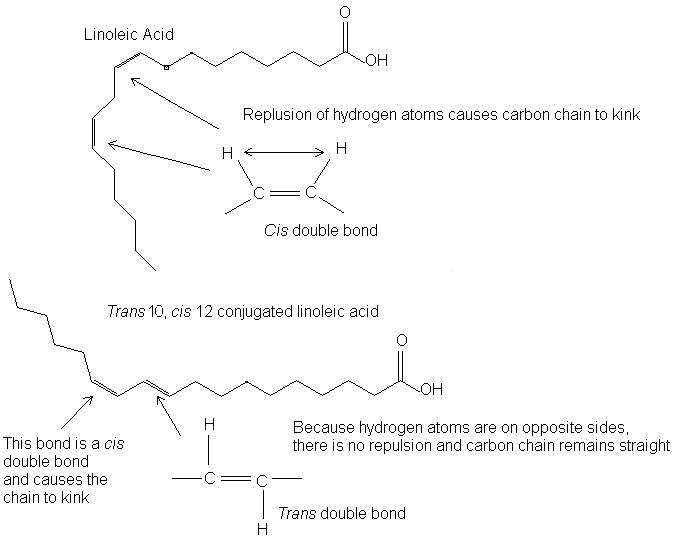Conjugated linoleic acid (CLA) is a group of structurally related isomers of the essential fatty acid linoleic acid (LA, C18:2 (n-6)) (figure 1 and 2). Conjugated linoleic acid is of interest to nutritional scientists and athletes because it may be beneficial to body composition. While a number of the isomers are present in the human diet mainly from dairy and ruminant sources, research attention has focussed on two of these, cis-9, trans-11 CLA and trans-10, cis-12 CLA. These two isomers have different effects in mammals that were first characterised in animal experiments on rodents and more recently confirmed in human studies. For example, the trans-10, cis-12 isomer of CLA is thought to be responsible for the body fat loss effects of CLA, while the cis-9, trans-11 isomer may enhance growth and feed efficiency. However, both substances appear to have anti-cancer effects, albeit by apparently differing mechanisms.
Figure 1. The structural difference between linoleic acid and conjugated linoleic acid.
Figure 2. The structure of linoleic acid and its isomers cis-9, trans-11 and trans-10, cis-12 conjugated linoleic acid.
The trans-10, cis-12 isomer of CLA is thought to be able to inhibit body fat accumulation by a number of mechanisms. One mechanism has been reported to be the inhibition of adipocyte lipoprotein lipase. Lipoprotein lipase is responsible for de-esterifying triglycerides to allow uptake of fatty acids to adipocytes, and therefore trans-10, cis-12 CLA may decrease the uptake of fatty acids, thus preventing deposition of triglycerides. This may also explain its ability to reduce hypertension, because non-esterified fatty acids can inhibit nitric oxide synthase and thus cause endothelial dysfunction. The trans-10, cis-12 isomer of CLA may also inhibit the differentiation of pre-adipocytes and increase apoptosis of pre-adipocytes. In addition, trans-10, cis-12 CLA may increase fat oxidation in skeletal muscle, which explains the increased energy expenditure and oxygen consumption in some studies.
In humans, CLA supplementation has proved effective at reducing body fat and improving body composition. However, not all clinical trials have shown positive effects, as is common when design, subjects and research goals vary between studies. Generally, concentrated forms of CLA in capsule at doses of between 3 grams per day and 7 grams per day have shown that CLA is effective at causing fat loss in humans1. This is supported by data from animal experiments. Compared to a placebo, CLA causes body fat loss in humans, but is interesting in that when combined with physical activity, may concomitantly increase lean mass. In this way CLA may have similar effects to ephedrine, albeit through completely different physiological mechanisms. This may suggests that synergistic effects exist between the two, although no research to date has been performed.
In one study published in the International Journal of Obesity2, researchers used a placebo controlled double-blind study to investigate the effects of 6 months of CLA ingestion in overweight subjects. Participants with body mass indexes of between 25 and 30 kg/m2 consumed 3.2 g of CLA per day for 6 months over the Christmas holiday period, when weight gain might be expected. The control group gained 0.77 kg body fat during this period, but the subjects consuming the CLA lost 1.07 kg. Body fat percentage also increased in the control group and decreased in the treatments group. Both body fat gain and body fat percentage changes were significant between the groups. However, the results showed no change in fat free mass or in resting metabolic rate between the two groups. This may relate to the dose administered or the fact that physical activity was not performed.
RdB


